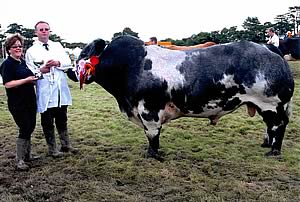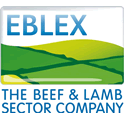2009-07-30
The Andreayas herd, owned by Allan and Sandra Jones, has been recognised by EBLEX as the Most Improved Herd for the British Blue breed for 2008/09.
Sandra and Allan Jones with British Blue Bull –
Twyning Ash Woody at Manx Show.
 |
The award is presented by the EBLEX Beef Better Returns Programme (Beef BRP), to the recorded herd that shows the greatest genetic gain for commercial traits over a 12-month period. There is a separate award for each of ten UK breeds.
Allan and Sandra Jones farm 147ha (360 acres) of grassland and have 12 pedigree British Blue cows and 70 commercial sucklers – mainly Simmental crossed with Belgian Blue, Aberdeen Angus or British Blonde. There is also a flock of 80 Texel cross sheep and a small flock of pedigree Beltex. In addition, the Jones’ run a four-star bed and breakfast enterprise.
The Andreayas herd was established ten years ago with the purchase of a pedigree British Blue bull from a Carlisle sale, along with an in-calf cow with calf at foot.
The Jones began recording immediately when the first cow calved. They use tools such as Estimated Breeding Values (EBVs) for important traits like muscle depth and growth rate, to ensure the herd progresses in the right direction. They also find having figures helps when marketing individual animals.
“EBVs allow us to discuss a bull’s potential performance with confidence,”
Mr Jones explains. “Having the data shows our customers that we can back up our claims.
“Many producers are now specifically seeking high index bulls, to produce high index animals. We now have a waiting list of pedigree breeders and commercial beef producers who wish to buy our bulls.”
Calving starts indoors at the beginning of March, with the calves turned out as soon as possible. A little creep is offered from August, before weaning in early November when they are brought indoors. They are then fed silage, plus a cereal/compound ration.
The pedigree bulls are sold on for breeding at 24 months of age. Any surplus females are taken to the Chelford sales and sold to other pedigree breeders.
“When choosing females to keep for breeding, we look for good length and height and for those from milky mothers,” Mr Jones explains.
“For bulls, we are looking at their growth potential, eye muscle depth, and calving ease. We use the pedigree bulls on our commercial herd as well, and breed type and temperament are also important. We don’t like them to be very extreme – they have to be well-balanced and good on their feet.”
There are currently three British Blue and one Simmental stock bull on the farm. British Blue Twyning Ash Woody was purchased two years ago. In the top 2% for the breed index, the Jones’ picked him for his length and good muscling. So far, they have had seven young bulls from him who are all showing good potential and good figures. The first of them will be ready for sale next year.
Bulls are sold off the farm with many regular customers, such as Kevin Kinrade, waiting for bulls to become available.
Mr Kinrade, who farms 138ha (340 acres) close to the Jones, runs 100 Limousin cross suckler cows and 200 ewes. All the youngstock is finished on the farm. Two Limousin bulls are used to produce replacements and are used on the heifers. Two British Blue bulls, including one from the Jones, are used to produce the beef calves.
The male animals are finished on a barley/straw diet at around 12-13 months of age at a target 265 – 326kg carcase weight. Heifers finish off grass in summer, or in the autumn off ad-lib silage and barley, at around 18-24 months of age. The British Blue crosses consistently score an R or better for conformation.
“With some breeds it is a struggle to get heifers to 265kg without getting them too fat,” Mr Kinrade adds. “But with the British Blue this hasn’t been a problem.”
Bulls are selected on ease of calving and temperament, but also figures for traits such as growth rate and muscle depth.
“Buying a bull with EBVs gives you a realistic indication of what he might be able to achieve,” says Mr Kinrade. “You can then match this knowledge with your females more accurately.”
EBLEX breeding specialist Samuel Boon agrees.
“EBVs are measurements of genetic potential and provide a reliable insight into the effect a bull could have on the herd,” says Mr Boon. “It means producers can make informed purchasing decisions rather than leaving it to chance, and hoping the chosen bull will deliver on the commercially important traits.
“All the winners of the Improved Herd Awards record the performance of their herds. All are providing valuable information that can help customers produce animals that make them money because they meet producer, processor, retailer and consumer demand, and do so as efficiently as possible.
“I congratulate Allan and Sandra Jones on the excellent job they are doing with the Andreayas herd.”
 Westwilmer Herd Wins EBLEX Award for Aberdeen Angus Breed Westwilmer Herd Wins EBLEX Award for Aberdeen Angus Breed
 Elmtree Herd Wins Most Improved Award for Limousin Breed Elmtree Herd Wins Most Improved Award for Limousin Breed
 Hackleton Aimee Supreme Blonde at Royal Welsh Show Hackleton Aimee Supreme Blonde at Royal Welsh Show
|



